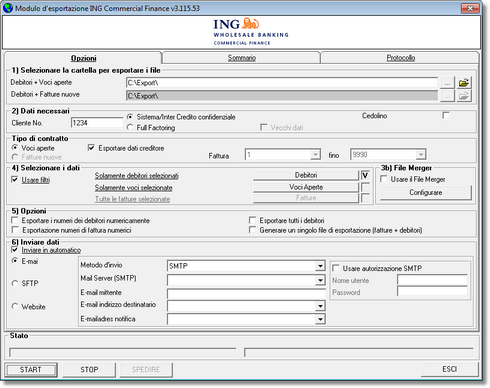This chapter describes the use of the export module for ING Commercial Finance. This module can be used to create export files that contain debtor and invoice information in the format expected by ING Commercial Finance. The following topics are covered:
Menu items: 'Export', 'ING Commercial Finance'
Use the menu options mentioned above to open the export module for ING Commercial Finance.

When the export module is opened, it is suggested to import the latest financial information. Always import this information if new entries were entered into the accounting package since the last time that information was imported into d-basics.
The following initial configuration is required:
•Export directory
The export directory is the location where export files will be saved. The default location is: 'c:\export'. To select a different location, push the ![]() button at the end of the text box and browse to the desired location.
button at the end of the text box and browse to the desired location.
•Account number
Enter the ING Commercial Finance account number (4 numbers).
•Contract
Depending on the type of factoring contract, d-basics can create two different sets of export files:
1) Confidential system
If the option 'Confidential system' is selected the following export files will be created:
•A file containing debtor information
•A file containing outstanding items
2) Open system
If the option 'Open system' is selected the following export files will be created:
•A file containing debtor information
•A file containing new invoices
III. Creating and sending export files
To create export files, the following steps must be completed:
Step 1: Verify month- or pledge agreement number
Verify the month- or pledge agreement number before export files are created. The month number must correspond with the month during which the files are send, the pledge agreement number must always be 1 higher then the pledge agreement number of the previous upload.
Step 2: Selecting transferable new invoices
In case of an 'Open system' factoring contract only the new invoices must be sent to ING Commercial Finance. D-basics keeps record of which invoices have already been transferred and automatically selects the new invoices. The first and last invoice of the range selected by d-basics are displayed (item 3). This selection can be modified by selecting a different first or last invoice.
Step 3: Setting filters
Filters can be used to exclude information from export files. For more information see paragraph 'Using filters'.
Step 4: Creating export files
Push 'Start' to create export files. Before export files are actually created, d-basics performs the following checks:
•Are all required parameters set?
Required parameters that are missing or not entered correct are displayed in red. In order to proceed, the correct values must be entered.
•Are the country, language and currency codes matched to the corresponding ISO codes?
If the country, language or currency codes that are used in the accounting package are not compliant with the international ISO standard, these codes must be linked to the matching ISO codes before export files can be created. For more information see the 'Match ISO codes'.
Notes: •Each time export files are created, d-basics checks whether all codes that are used in the accounting package are linked to the matching ISO codes. D-basics cannot create export files until all codes are linked with the matching ISO codes. •It is possible to schedule import and export actions. For more information see 'Automatic import and export'. |
Step 5: Sending export files
After creating the export files, d-basics offers the possibility to browse to the Credit View website. This website can be used to send the export files to ING Commercial Finance. See the manual provided by ING Commercial Finance for information regarding the use of the Credit View website.
Step 6: summary and Log
After creating export files, the proceedings of d-basics can be reviewed:
•summary
The second tab of the Export module shows a summary of the information that was retrieved from the ledger (administration) in the accounting package.
•Log
The third tab of the Export module shows the export log. The export log gives a summary of the events that took place during the import and export of information.
See the appendix 'Events log file' for an explanation of the events mentioned in the export log.
Note: •Most of the errors mentioned in the log file can be fixed by changing the information in the ledger (administration) in the accounting package. •'Error- and Truncate events are only registered if the corresponding checkbox is checked. It is recommended only to use this feature for debugging purposes, since it has a negative impact on the performance of d-basics. |